Photography courtesy of Lowell Washburn, all rights reserved.
My initial exposure to the ancient art of duck hunting was a memorable occasion. I had barely settled into the blind when the first flock of web-foots appeared. They were blue-winged teal, on the deck and traveling at warp speed. As they passed the blind, the birds suddenly took interest in our decoys. Executing a spectacular U-turn, the compact formation came scorching back to the spread. Within seconds, the ducks — all 15 or 20 of them — were noisily splashing in among my Dad’s wooden blocks.
Obtaining a firm grasp on the obvious, I suddenly realized that here was an easy opportunity to collect my very first duck dinner. I made my move at the same instant the surprised teal made theirs. By the time I had the gun to my shoulder, the ducks were long gone. All that remained of my duck dinner were converging ripples on the pond’s surface.
The year was 1959. As a .410 totin’ ten-year-old, the sight of those ducks coming to the decoys represented a life changing experience. I was immediately, thoroughly, and forever hooked. Fifty-eight duck seasons later, I find the sight no less thrilling than I did as a greenhorn kid.
My total fascination with bird decoys began at an early age. Long before I would actually see the counterfeits in action, I would climb to the garage loft and drag Dad’s decoys out of their bins. After placing a few on a rain puddle, I would just sit and stare. If no water was available I’d place them on the lawn, and then I would just sit and stare. Coolest things ever, I would think to myself.
Following that first duck hunt, my fascination grew stronger. During the week, I lived for brief after school duck hunts. Saturday mornings were incredible. On Saturdays, I could actually be on the marsh at the crack of dawn to watch as black silhouetted ducks cupped their wings and descended to our spread
By the time I hit Junior High, I had begun earning a bit of pocket money – everything from want ad leaf racking to scraping paint off wooden siding. I used some of my new-found riches to acquire a few decoys of my very own. There was no lack of places to spend my decoy money. Most hardware and department stores sold hunting supplies – including decoys. There were three sporting goods outlets on the four block Main Street in my hometown of Clear Lake. In the nearby community of Fertile, you could even buy duck decoys, along with guns, ammo, boots, and muskrat traps in the back room of the local grocery store. It was a great time to be a kid.
By now, factory produced wooden decoys were pretty much a thing of the past. The current market was being inundated by decoys fashioned from highly durable papier-Mache. Carry-Lite and the General Fibre Company’s, St. Louis Ari-Duk quickly dominated the market. Fiber decoys had a lifelike profile, glass eyes and air brushed paint. Best of all, they were virtually weightless when compared to wood. Factory technology continued its outdoor advance. Before long, a wide variety of plastic decoys began making their debut. Produced by a seemingly endless number of companies, plastic decoys came in all shapes and sizes. Most new plastics were OK, at best. Many were real junk, leaking like sieves after a few trips to the water. But there was one decoy that stood out above all others. The Herter’s line of high grade tenite ducks quickly became the gold standard of plastic decoys.
Founded in the 1930s and based in Waseca, Minnesota, Herter’s was the national prototype for the giant outdoor merchandisers like Cabela’s, Bass Pro, and Gander Mountain that would appear later. The Herter’s Company was unique in that it only sold Herter’s Brand products. During the 1960s, EVERYONE read the Herter’s mail order catalog. With more than enough pages to stop a .22 Long Rifle, the gargantuan catalogs contained photos and glowing descriptions for every single “Herter’s Model Perfect” product currently under production. The catalog’s propaganda laced testimonials were enough to make a traveling snake oil salesman blush with shame. But the catalog did make for entertaining reading and – outrageous claims aside — most of the products were solid.
During the 1960s, Herter’s began to market a new and improved line of decoys constructed from a remarkable substance called duralon – a high density, advancement in Styrofoam. Equipped with internal self-righting keels and swiveling tenite heads, Herter’s duralon decoys took the waterfowling world by storm. Eager to get our hands on some, my High School buddies and I decided a mail order would be too slow. Climbing into Brian Trumbull’s green Studebaker, we headed for Minnesota. After arriving at the company’s Waseca show room and seeing the decoys for ourselves, we quickly shucked out the exorbitant sum of $14.00 per dozen for as many as our vehicle would hold. Abandoning the boxes at the store and leaving the mallard heads unattached, we stacked decoy bodies like cordwood all the way to the car’s ceiling. Filling every additional nook and cranny, we stuffed some more into the back window, under the seats, and filled the trunk. Grinning from ear to ear, we returned to Iowa decoy rich.
That could have been the end of my decoy purchasing; but it wasn’t. A born sucker for a new product sales pitch, I’ve been buying decoys ever since. I never get rid of the old ones, of course. I just keep adding to the pile. Today, I have mountains of decoys, ready at the drop of a hat, to address any situation. For shallow marshes, there are stacks of mallards, pintails, wigeon and teal. For the big waters, there are bluebill, redhead, canvasback, and bufflehead decoys. A couple dozen colorfully painted wood ducks are reserved for willow sloughs and wooded backwaters. There are also piles of floating Canada geese and a trailer full of full body and silhouette goose decoys for the fields. There are also snow goose floaters and shell decoys, not to mention an unknown number of white wind socks and Texas rag field decoys. Have I mentioned turkey, deer or dove decoys? I also have egret, swan, prairie chicken, and pheasant decoys that I sometime use for obtaining closeup wildlife photos.
Every year I tell myself that this is it. Enough is enough. I am not buying one more decoy of any kind – EVER! And then I see it. A new product that is so stunningly realistic that it would simply be impossible for any duck or goose to pass it by. Next thing I know, the dog starts barking and I realize that the new decoys have arrived at my door. Opening the box, the birds are so beautifully lifelike, so finely detailed that I immediately place a few on the lawn. After that, I just sit and stare. Coolest things ever, I think to myself.
This year is going to be different. Enough is enough. No new decoys. Period. That is, of course, unless I see something that I couldn’t possibly live without.

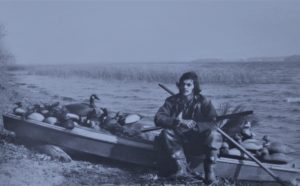
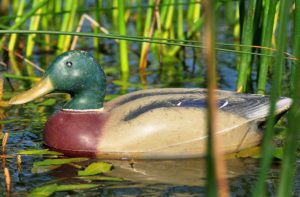
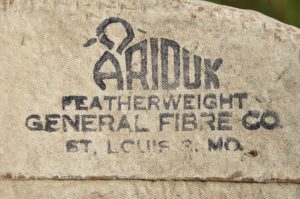
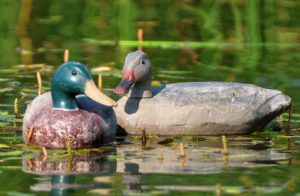
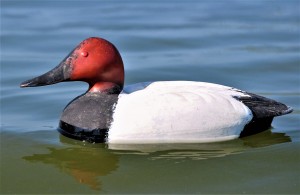
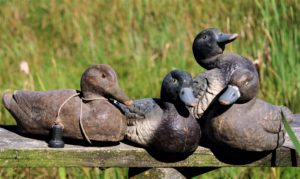
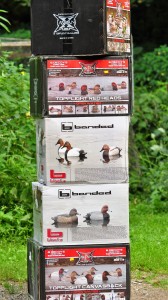
 Tom Cope
Tom Cope Sue Wilkinson
Sue Wilkinson Susan Judkins Josten
Susan Judkins Josten Rudi Roeslein
Rudi Roeslein Elyssa McFarland
Elyssa McFarland Mark Langgin
Mark Langgin Adam Janke
Adam Janke Joe Henry
Joe Henry Kristin Ashenbrenner
Kristin Ashenbrenner Joe Wilkinson
Joe Wilkinson Dr. Tammy Mildenstein
Dr. Tammy Mildenstein Sean McMahon
Sean McMahon